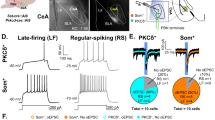Abstract
The central nucleus of the amygdala (Ce) is a terminal area of the major nociceptive ascending pathway, the spino-(trigemino)-parabrachio-amygdaloid tract. In our study, the Ce was bilaterally electrolytically lesioned in male albino rats. Nociception was assessed by the tail flick latency, which was later compared with the corresponding values in intact and sham-lesioned rats. Stereotactic electrolytic bilateral lesioning of the Ce significantly decreased the sensitivity to pain. In addition, the diurnal variation in the pain sensitivity observed in control animals was noticeably smoothed.
Similar content being viewed by others
References
M. R. Brown and T. S. Gray, “Peptide injections into the amygdala of conscious rats: Effects on blood pressure, heart rate and plasma catecholamines,” Regulat. Peptides, 21, 95–106 (1988).
P. A. Hopkins and G. Holstege, “Amygdaloid projections to the mesencephalon, pons and medulla oblongata in the cat,” Exp. Brain Res., 32, 529–547 (1978).
G. J. Mogenson and F. R. Calaresu, “Cardiovascular responses to electrical stimulation of the amygdala in the rat,” Exp. Neurol., 39, 166–180 (1973).
P. G. Henke, “The centromedial amygdala and gastric pathology in rats,” Physiol. Behav., 25, 107–112 (1980).
A. Ray, P. G. Merike, and R. M. Sulliwan, “Effects of intra-amygdalar dopamine agonists and antagonist on gastric stress lesions in rats,” Neurosci. Lett., 84, 302–306 (1988).
A. Ray, P. G. Merike, and R. M. Sulliwan, “Opiate mechanism in the central amygdala and gastric stress pathology in rats,” Brain Res., 442, 195–198 (1988).
B. N. Manning and D. J. Mayer, “The central nucleus of the amygdala contributes to the production of morphine antinociception in the tail flick latency tests,” J. Neurosci., 15, No. 12, 8199–8213 (1995).
J. F. R. Konig, R. A. Klippel, B. Lange, and U. Grunwald, The Rat Brain: a Stereotaxic Atlas of the Forebrain and Lower Parts of the Brain, Williams and Wilkins, Baltimore (1963).
G. Paxinos and C. Watson, The Rat Brain in Stereotaxic Coordinates, Academic Press, New York (1986).
J. P. Rasenfeld and P. E. Rice, Diurnal rhythms in nociceptive threshold of rats, Physiol. Behav., 23, No. 2, 419–430 (1979).
R. L. A. Frederickson, V. Burgis, and J. D. Edwards, “Hyperalgesia induced by naloxone follows diurnal rhythm in responsivity to painful stimuli,” Science, 198, 756–758 (1977).
B. S. Kapp, P. J. Whalen, W. F. Supple, and J. P. Pascoe, “Amygdaloid contributions to conditioned arousal and sensory information processing,” in: The Amygdala: Neurobiological Aspects of Emotion, Memory, and Mental Dysfunction, J. P. Aggleton (ed.), Wiley, New York (1992), pp. 229–254.
J. E. LeDoux, “Brain mechanisms of emotion and emotional learning,” Curr. Opin. Neurobiol., 2, 191–197 (1992).
J. E. LeDoux, “Emotion and the amygdala,” in: The Amygdala: Neurobiological Aspects of Emotion, Memory, and Mental Dysfunction, J. P. Aggleton (ed.), Wiley, New York (1992), pp. 339–352.
M. Davis, “The role of the amygdala in conditioned fear,” in: The Amygdala: Neurobiological Aspects of Emotion, Memory, and Mental Dysfunction, J. P. Aggleton (ed.), Wiley, New York (1992), pp. 255–305.
J. G. Veening, “Subcortical afferents of the amygdaloid complex in the rat: an HRP study,” Neurosci. Lett., 8, 197–202 (1978).
S. Roder and J. Ciriello, “Innervation of the amygdaloid complex by catecholaminergic cell groups of the ventrolateral medulla,” J. Comp. Neurol., 332, 105–122 (1993).
J. A. Ricardo and E. T. Koh, “Anatomical evidence of direct projections from the nucleus of the solitary tract to the hypothalamus, amygdala, and other forebrain structures in the rat,” Brain Res., 153, 1–26 (1978).
Author information
Authors and Affiliations
Corresponding author
Additional information
Neirofiziologiya/Neurophysiology, Vol. 38, No. 3, pp. 231–234, May–June, 2006.
Rights and permissions
About this article
Cite this article
Balasubramanian, C., Krushna Pal, G. & Konar, D.B. Effect of stereotactic ablation of the central nucleus of the amygdala on pain sensitivity among rats. Neurophysiology 38, 193–196 (2006). https://doi.org/10.1007/s11062-006-0045-7
Received:
Issue Date:
DOI: https://doi.org/10.1007/s11062-006-0045-7




